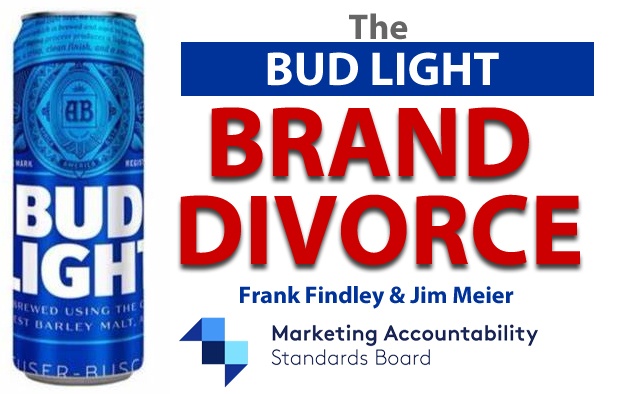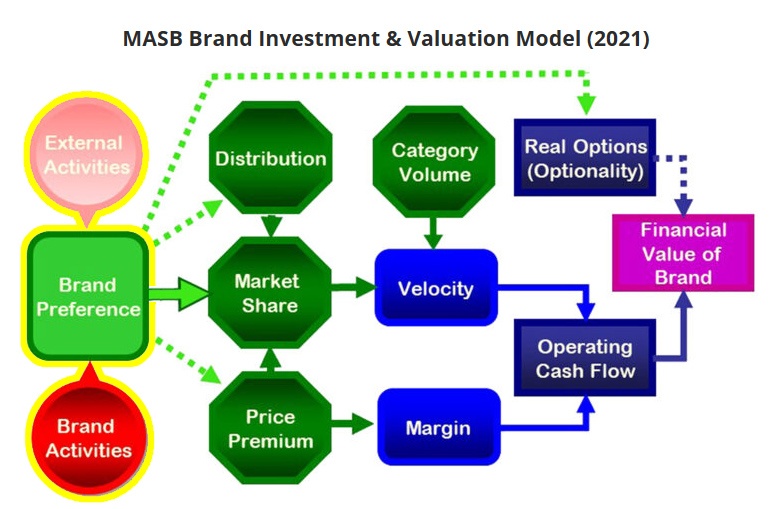
Background
From May through September of 2023, the Marketing Accountability Standards Board (MASB) published three articles that were compiled into the white paper, The Bud Light Brand Divorce: How impaired brand preference led to persistent sales volume decline. Now, with a full one-year cycle of market reaction nearly complete, we are providing an update on recent activity with our perspective on what can reasonably be expected looking forward.
Scenario Recap
In early April 2023, social media influencer Dylan Mulvaney released March-Madness-related, sponsored Instagram posts promoting Bud Light that were immediately met by a wave of criticism within social media. Within days, the news media was heavily covering the “Bud Light Boycott” story, mostly downplaying the likelihood of a prolonged monetary impact.
MASB used its Brand Investment & Valuation (BIV) model to suggest that Bud Light’s travails were not the short-term consequence of a traditional boycott and would not respond to remedies typically associated with boycotts. Rather, a combination of exceptional marketing activities coupled with positive external influences would be necessary for a turn-around.

The Bud Light Sales Decline Persists and Is Likely to Continue
No publicly issued sales results for Bud Light over recent months indicate any improvement in earlier declines. In their fourth quarter and calendar year 2023 earnings call on Feb. 13, Molson Coors provided several hints as to what has happened and what can be expected to come in the trade:
- Coors Light volume growth in the fourth quarter exceeded that in the second quarter.
- Coors Light and Miller Lite gained 6 to 7% more retail distribution during summer and fall shelf adjustments.
- Molson Coors expects to gain significantly more distribution and space in 2024 resets during March through July.
- During this time frame, integrated marketing campaigns are planned across TV, digital, retail, and live events.
- In the four weeks leading up to the Super Bowl, Coors Light added an incremental 160,000 display units at retail, during which time velocities grew by nearly 14%.
- Molson Coors CEO Gavin Hattersley stated that Molson Coors research shows “the majority of consumers who switched to our brands post April have stayed with us throughout 2023” and appear to be very loyal.
- Hattersley reaffirmed that the U.S. industry share shift is permanent, and in 2024, Molson Coors is “leading all brewers in year-to-date dollar share growth.”
Items #2 and #3 above should be particularly alarming to the caretakers of Bud Light. These core declines in consumer-facing distribution, if true and sustaining, will only serve to institutionalize the brand’s decline.
Additionally, as represented in the BIV model, External Activities include competitor activities. It seems abundantly clear that the primary beneficiary of Bud Light’s sales decline, Molson Coors, is stepping on the gas to leverage this market opportunity.
Bud Light Is Attempting to Respond
In our September article, we stated, “While Bud Light has ramped up Brand Activities in the form of strong media spending, we doubt that all of this nets out significantly enough in Bud Light’s favor. All things considered, a continuation of the brand divorce over the near term seems most likely.”
Among the efforts to revive sales momentum, Bud Light ran a 60-second commercial during the Feb. 11 broadcast of the Super Bowl. It included the tag line, “Easy to Drink, Easy to Enjoy,” and featured retired NFL quarterback Payton Manning and musician Post Malone, as well as a new character called the Bud Light Genie. In our view, this commercial was much more in the traditional vein of Bud Light’s successful Super Bowl efforts of the past.
Nonetheless, an analysis of Nielsen data by Bump Williams Consulting indicated that U.S. sales volume for Bud Light declined 30% in the two-week period ended Feb. 17 that bracketed the Super Bowl. [1]
In AB InBev’s Feb. 29 earnings release for their fourth quarter and calendar year 2023 results, reported organic revenues for the North America segment (largely U.S. but also including Canada) declined $1.378 billion from 2023, and gross profit declined $1.227 billion. While a chart in the earnings presentation showed that U.S. market share per Circana showed improvement from May 2023 through February 2024, the improvement was quite modest. The May 2023 market share decline of 5.63 pp improved to a decline of 4.62 pp in January 2024 and then to a decline of 4.43 pp in month-to-date February results. We suspect that much of this improvement is due to the performance of brands other than Bud Light.
References to a “Boycott” Inexplicably Continue
MASB’s assertion all along has been that this scenario is more illustrative of a brand “divorce” than a “boycott.” The term “boycott” continues to propagate in most media coverage to this day. We believe this is a severe misrepresentation. The very important dynamics that distinguish a “brand divorce” have underpinned the point of view that Bud Light’s sales declines would endure.
A boycott is a form of protest where a group of customers collectively refuse to use or buy products from a certain brand or company. Further, boycotts may be launched by an organization which issues demands to be met by the company for the boycott to be ended.
In significant contrast, a brand divorce describes a relatively permanent loss of customer brand preference by a product. There are no accompanying demands to be met, and the situation may or may not be short lived. One year later, Bud Light’s situation is now quite far from short-lived.
Impact on Category Volume
In our September article, we also stated, “MASB sees a caution flag, however, in that just as the market-share leader in a category tends to lead category expansion, the opposite can also be true on the downside. We suggest this is a ‘watch list’ item as the next months proceed, but we do not see it as inevitable, in part because the segment alternatives will gladly participate in their newfound wealth.”
In the Feb. 13 earnings call, Molson Coors’ Hattersley stated, “Contrary to conventional wisdom, U.S. beer industry volume trends improved during 2023 and particularly in the fourth quarter, which was consistent with strong improvements in consumer spending. In fact, the overall beer category gained dollar share of total alcohol beverage in 2023.”
Brand Management Woes Can Lead to Broader Business Impacts
While brand management woes (and successes) are often most quickly and obviously felt in the Marketing and Sales Divisions of the affected company, the impact of the Bud Light situation has more than just mildly crept into other stakeholder groups, including employees, suppliers, and distributors.
For instance, while AB InBev recently averted a strike by its 5,000 Teamsters employees across its 12 U.S. breweries, one demand in the contract negotiation was a guarantee of no brewery closures. Reports indicate that the new 5-year contract includes language to protect all Teamsters members’ jobs for the life of the contract. [2]
Stories prevail about how suppliers who provide input materials to AB InBev’s U.S. operation, especially if captive to AB InBev, have been significantly impacted. But nowhere has the financial damage been more devastating than with independent beer distributors in the U.S., as they lack the geographic diversification of AB InBev. Within local geographies, undoubtedly tens of millions of dollars of enterprise value have shifted between independent distributors, many still family-owned, in what is likely a dollar-for-dollar enterprise-value shift from the AB InBev distributor to the Molson Coors distributor.
There may be no better illustration of how marketing activities can impact brand preference, leading to an impact on brand value, and carrying through to an impact on enterprise value.
MASB Resources Are Available
In additional to the white-paper compilation previously mentioned, MASB also has available at no cost a turn-key academic case study including a brief introductory video, a PowerPoint presentation, and an instructional guide. Request the Bud Light Brand Divorce Case Study from info@themasb.org.
References
1. Wall Street Journal, wsj.com/business/retail/bud-light-missed-out-on-the-super-bowl-party-a5387584
2. Wall Street Journal, wsj.com/business/anheuser-busch-teamsters-avert-strike-with-tentative-deal-7fcb3adc/
The Authors
 Jim Meier served as MASB Director (2013-2018) and was appointed Trustee and Treasurer of the Marketing Accountability Foundation in 2019. He graduated from Marquette University in 1984 with a Bachelor’s degree in Accounting. After eight years as an auditor with Ernst & Young, he spent 26 years with Philip Morris, Miller Brewing Company and MillerCoors in financial support roles across Corporate Financial Services, Sales, Integrated Supply Chain, and Marketing. In his final role, VP Commercial Finance, Jim reported directly to the CFO and on a dotted-line basis to the CMO and CSO. He was closely involved with annual marketing spending allocation, on-going assessment of marketing mix modeling, and application of ROMI principles in both the Marketing and Sales divisions. Most recently, Jim has been engaged in assisting startup companies connected with a venture capital fund.
Jim Meier served as MASB Director (2013-2018) and was appointed Trustee and Treasurer of the Marketing Accountability Foundation in 2019. He graduated from Marquette University in 1984 with a Bachelor’s degree in Accounting. After eight years as an auditor with Ernst & Young, he spent 26 years with Philip Morris, Miller Brewing Company and MillerCoors in financial support roles across Corporate Financial Services, Sales, Integrated Supply Chain, and Marketing. In his final role, VP Commercial Finance, Jim reported directly to the CFO and on a dotted-line basis to the CMO and CSO. He was closely involved with annual marketing spending allocation, on-going assessment of marketing mix modeling, and application of ROMI principles in both the Marketing and Sales divisions. Most recently, Jim has been engaged in assisting startup companies connected with a venture capital fund.
 Frank Findley is a data scientist and Executive Director of MASB where he represents the U.S. in the creation of international (ISO) marketing standards. His previous work at ARS group, comScore, and MSW Research resulted in improvements to ad testing, tracking, media planning, and competitive intelligence systems. He is a coinventor of the patented Outlook media planner. His research has appeared in publications including the Journal of Advertising Research, Quirk’s, Forbes, and the books Accountable Marketing (Routledge, 2016) and Master of Marketing Measurement: Margaret Henderson Blair on Marketing Accountability (Cambridge Scholars, 2021). He was presented the 2021 ARF Great Minds Award for Best Practitioner Paper. He is a regular speaker at conferences and a participant on marketing industry boards.
Frank Findley is a data scientist and Executive Director of MASB where he represents the U.S. in the creation of international (ISO) marketing standards. His previous work at ARS group, comScore, and MSW Research resulted in improvements to ad testing, tracking, media planning, and competitive intelligence systems. He is a coinventor of the patented Outlook media planner. His research has appeared in publications including the Journal of Advertising Research, Quirk’s, Forbes, and the books Accountable Marketing (Routledge, 2016) and Master of Marketing Measurement: Margaret Henderson Blair on Marketing Accountability (Cambridge Scholars, 2021). He was presented the 2021 ARF Great Minds Award for Best Practitioner Paper. He is a regular speaker at conferences and a participant on marketing industry boards.
About MASB
The Marketing Accountability Standards Board is the acknowledged expert body on the topics of brand evaluation, brand valuation, and marketing return on investment. ANSI, the American National Standards Institute, has designated MASB to serve as the U.S. representative to the ISO technical committee charged with setting global standards on such matters. MASB’s game-changing initiatives are elevating the CMO to their rightful place in the boardroom by making marketing accountable.
